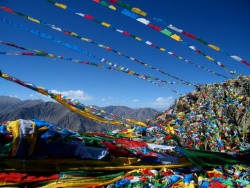A Review of Tibetan Ritual
Tibetan Ritual undertakes the long-overdue task of exploring myriad forms of Buddhist and Bön ritual in Tibetan and Himalayan contexts with several contributions about Mongolia as well. The rituals addressed in its eleven chapters make clear that Tibetan religions are not only highly ritualized, but that much of its ritual activity centers on apotropaic concerns rather than soteriological ones. As such, Tibetan Ritual inducts the reader into an alternative side of Tibetan Buddhism in its interactions with Bön, beyond its current public face of compassion and tantric soteriology, into the more fierce and ethically-edgy forms of apotropaic rituals—from rites to avert armies and cheat death to exorcisms and propitiatory sacrifice.
One of the commendable features of this volume is the careful balance between textual and ethnographic research on Tibetan ritual as liturgical text and embodied performance. In Tibetan Ritual, one will find historical and philologically-informed discussions, such as what Dunhuang manuscripts can tell us about the evolution of the cult of Vajrakīla (Rdo rje phur ba) in Tibet by Robert Mayer and Cathy Cantwell, alongside ethnographic studies such as Françoise Pommaret’s description of Bhutanese pilgrimages to central Tibet and Marc des Jardins’s first-hand account of healing practices using burning stones at a Bön monastery in eastern Tibet. More unusual and captivating are narrative accounts of ritual, such as James Gentry’s analysis of the autobiographical account by Sog bzlog pa Blo gros rgyal mtshan of his ritual interventions to avert Mongolian armies.
More commendable still are the chapters that combine textual and ethnographic research on Tibetan ritual. For example, Nicolas Sihlé examines the social economy of texts among a tantric community in Mustang in order to discern how exogenous texts are domesticated into a local context. He deftly traces how non-clerical tantrists appropriate selections from widely circulating ritual cycles into a bricolage, adapted to conform to local conditions and interpretive frameworks. His study is emblematic of a new type of interdisciplinary and theoretically engaged scholarship emerging in Tibetan Studies, which is sensitive to texts as mutable sources for doctrinal understandings and embodied performance as well as significant markers of status and authority.
Sihlé’s refreshing approach to the processes that texts undergo as they are circulated, compiled, recited, and ritually enacted (rather than viewing texts as static entities with fixed meanings) is also evident in the work of other contributors. In their chapter on Vajrakīla texts from Dunhuang, Robert Mayer and Cathy Cantwell highlight the process of indigenization that adds locally-inflected frames, anchored in Tibetan charter myths, to early Buddhist tantric literature and, in the process, subtly re-contextualizes source material inherited from India in Nyingma ritual collections over the centuries. Along similar lines, Yael Bentor explores how the meaning of a single verse of the Guhyasamāja Tantra was transformed in subtle ways during its translation from Sanskrit to Tibetan and describes the impact that this had on the development of Tibetan commentarial traditions on the tantra. Finally, Vesna Wallace charts out textual processes in the cult of the book in Mongolia, describing the veneration of key Mahāyāna sūtras, like the Vajracchedikā and Suvarṇaprabhāsottama, and the apotropaic effects ascribed to ritualized acts of copying, reciting, reading, and explaining them.
The potential conflict between Buddhist ethics and some apotropaic rituals is tantalizingly suggested in several chapters. The most provocative example is the ritual to cheat death (‘chi bslu), described and analyzed by Irmgard Mengele. She identifies Indic antecedents to this ritual while also illuminating its distinctively Tibetan elements, namely the offering of an effigy and negotiations with spirits to release the beneficiary from an untimely death. Yet Mengele puzzles over the way that this ritual seems to contravene the inexorability of karma—which is precisely what is so interesting about apotropaic rituals in Tibetan Buddhism. One important clue, implicit in her account, is that apotropaic rituals, like those promising to cheat death, deal with immediate conditions (‘phral rkyen) in the form of obstacles rather than karma (as a primary cause) per se. As such they offer an immediate way to intervene in human misfortune that nonetheless operates within a Buddhist framework of causation, with karma only being marshaled as an explanation in cases of ritual failure. If we remember that the term karma in its ethicized form originally derives from ritual action—and still is used as such in categorizing apotropaic rituals into the four actions (las bzhi)—then a fruitful arena opens up in which to explore the seeming tensions between these two different types of actions in Tibetan Buddhist sources.
Ethics also make a brief appearance in a chapter by Jared Lingahl on the Buddhicization of mountain deity cults in Mongolia. As Lingahl notes, animal sacrifice is typically banned when an indigenous sacred site is converted into a Buddhist one by co-opting the mountain deity into the Buddhist pantheon as a protector or overlaying the maṇḍala of a tantric deity onto its terrain. Lingahl also mentions the ritual protocols at sacred mountains that contemporary interpreters have latched onto as an indigenous Mongolian environmentalism. This modernist transformation of ritual taboos into an environmental ethos is one of the fascinating confluences of ritual and ethics in Tibetan Buddhist contexts that remains to be more fully explored.
Although it boasts several ethnographically grounded studies, Tibetan Ritual as a whole leans heavily toward textual analysis. This may be a deliberate attempt to wrest the category of ritual from anthropologists or merely a sign of the lingering bias toward textual analysis in Tibetan Studies. In addition to this bias, some of the chapters rely somewhat anachronistically on early theories of ritual. For example, Samten Karmay introduces a Bön canonical source for propitiating gnyan spirits via the myth-and-ritual nexus. Likewise, Bryan Cuevas dredges up Tylor and Frazer to re-instate the category of magic in Tibetan Buddhism and to situate his discussion of the fascinating and little-known category of texts, called be’u bum, which are handbooks of arcane ritual knowledge.
Overall Tibetan Ritual provides a much-needed fulcrum for the emerging subfield of Tibetan ritual and most of its contributions derive from the 2007 conference on “The Practice and Theory of Tibetan Ritual” held at the University of California, Santa Barbara. Although Tibetan ritual has been of interest to French scholars for decades, exemplified in the seminal three-volume Essais sur le ritual from 1988, this volume is a landmark as an English-language publication. The introduction by José Cabezón provides a helpful overview of the Tibetan terms for ritual and the types of rituals, both Buddhist and Bön, found in Tibetan and Himalayan contexts. Moreover, the contributors to Tibetan Ritual do a capable job of describing and analyzing each of the specific types of ritual contained therein.
That said, we are a long way from creating a taxonomy of ritual genres in a comparable way to the more systematic study of Tibetan literary genres currently under way. Although we should be wary of how we constitute the semantic field of ritual, given Talal Asad’s genealogical critique of the term in its academic appropriation, a sensible enough starting point would be the taxonomies that Tibetans themselves engage when discussing ritual and arranging collections of liturgies, such as “higher actions” (stod las), which are soteriological in nature, and “lower actions” (smad las), which are apotropaic in nature and consist of the “four actions.”
The individual chapters of Tibetan Ritual are informative contributions by erudite scholars in Tibetan Studies, but lamentably the volume as a whole is not organized around a coherent thematic focus or set of theoretical concerns. For this reason, Tibetan Ritual may be of more interest to Tibetologists and specialists in Buddhist tantra than a larger Buddhological or Ritual Studies audience. That said, individual chapters provide salient points of comparison for those working on parallel issues, such as pilgrimage, syncretism, or sacred mountains within Buddhist Studies.
Footnotes
- ↑ University of Colorado. Email: gayley@colorado.edu
Source
Tibetan Ritual. Edited by José Ignacio Cabezón. Oxford: Oxford University Press, 2010, 320 pages, ISBN 978-0-19-539282-1 (cloth), $29.95.
blogs.dickinson.edu



